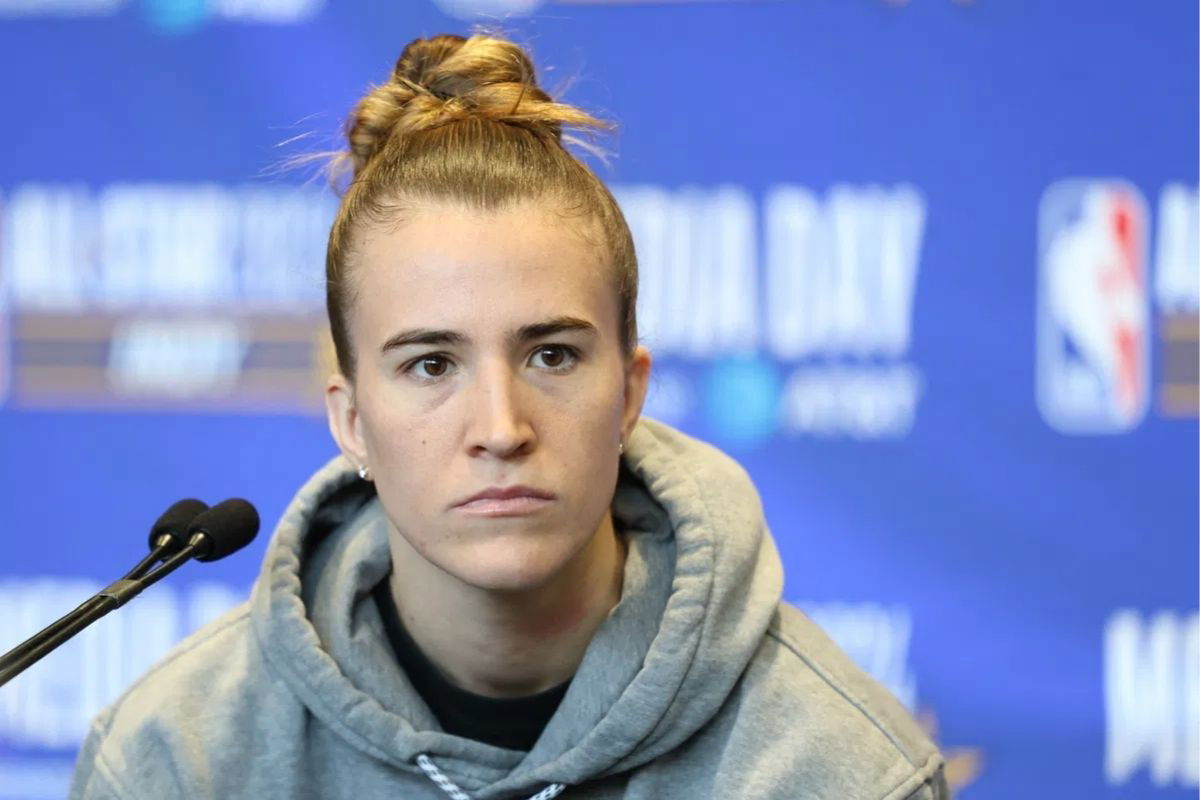
USA Today via Reuters
Feb 17, 2024; Indianapolis, IN, USA; New York Liberty guard Sabrina Ionescu (20) talks about the shooting contest against Steph Curry during NBA All Star practice press conferences at Gainbridge Fieldhouse. Mandatory Credit: Trevor Ruszkowski-USA TODAY Sports

USA Today via Reuters
Feb 17, 2024; Indianapolis, IN, USA; New York Liberty guard Sabrina Ionescu (20) talks about the shooting contest against Steph Curry during NBA All Star practice press conferences at Gainbridge Fieldhouse. Mandatory Credit: Trevor Ruszkowski-USA TODAY Sports
Team Collier spoiled the party for the Indiana faithful. Normally, there’s no “home team” in an All-Star Game, but with Caitlin Clark as the city’s adopted superstar, the crowd’s allegiance was crystal clear. Even in her absence, fans were all-in on Team Clark. However, that only fueled Team Collier, who steamrolled to a 151-131 win, shattering the record for most points ever in a WNBA All-Star Game. Team Clark was never in the race, as Collier’s squad maintained a dominant 20-point cushion from start to finish.
Collier herself put on an MVP-worthy showcase, dropping 36 points and pulling in nine boards, which was simply too much for Team Clark to handle. Still, for all the fireworks that were anticipated before the tip-off, the game’s intensity felt like it was running on fumes. And New York Liberty’s Sabrina Ionescu had an explanation for why the competitive spirit seemed to be missing.
She told the media, “I think it probably would have been a little bit more competitive if teams didn’t play in such a short amount of days. And I think that’s something as we’re talking obviously into our CBA and understanding like all Stars don’t really have a break. We finish we get on a flight the next day.”
ADVERTISEMENT
Article continues below this ad
The game was already compromised by the condensed schedule, with several All-Stars sidelined by injuries. Caitlin Clark had re-aggravated her groin, while Satou Sabally was already out due to an ankle issue. Even among those who did suit up, players like Angel Reese, who recently sat out a game to avoid further complications, were clearly holding back and not going all out.
ADVERTISEMENT
Article continues below this ad
Top Stories
Sabrina further said, “And so I think that’s something obviously as players. We want to be able to come out here during this time, put on a great show for the fans, but also take care of our bodies because we don’t have time. We enter now a grueling second half of the season and teams are trying to make playoff pushes. Players are trying to get back from injury, and so I think obviously that’s something as players we got to continue to stand on is maybe trying to get a few more days to where you know we can have a little bit more competitiveness in these games.”
Sabrina Ionescu says the All-Star Game would’ve been “more competitive” if there was a longer break before the regular-season resumes.
Games restart on Tuesday.
Q: @madkenney pic.twitter.com/RDBoyj41u4
— Colin Salao (@colincsalao) July 20, 2025
The league’s expansion, which involved adding a new team and packing more games into the same tight window, has set off a cascade of problems. Players like Satou Sabally are slogging through grueling stretches, sometimes 9 games in 18 days. And Sabrina Ionescu herself has had runs of 8 games with barely a day to recover in between. The result? An alarming spike in injuries: The Next’s tracker has already logged more than 141 injuries this season, fast approaching last year’s total of 203 and blowing past 2023’s 175.
ADVERTISEMENT
Article continues below this ad
With careers on the line and league-wide examples piling up right in front of them, players have every reason to hold back rather than risk everything for a flashy All-Star Game. With more teams set to be added from next year onwards, this problem will likely compound further.
New Teams to Worsen Old Problems
The Golden State Valkyries are enjoying a dream debut season, selling out their season tickets before opening night and leading the league in average attendance. On the court, they’ve held their own with a solid 10-12 record so far. But as the WNBA looks to expand to 18 teams by 2030, there’s growing concern. Injuries have already spiked with just one new team added, raising questions about how the league will manage player health in the seasons to come.
The WNBA’s Collective Bargaining Agreement (CBA) limits how many regular-season games can be played each year, and this season, the league hit that cap at 44 games, up from just 32 in 2021. With expansion on the horizon and TV revenues climbing, there’s growing pressure to add even more. But the real problem isn’t just the rising number of games – it’s that all of them still have to be crammed into the same compressed May-to-September window.
And pushing the season past October would cut into players’ lucrative overseas opportunities, even if bigger WNBA paychecks soften the blow. The roster issue is just as urgent: teams are still allowed only 12 spots, so when injuries inevitably mount, franchises patch holes using short-term hardship contracts. With the player talent pool expanding and injury numbers climbing, this Band-Aid approach simply won’t hold.
At least six WNBA teams share their home arenas with NBA teams, meaning they directly compete for availability as the NBA season ramps up in October. The big brother NBA takes precedence over the W. And if that was not complicated enough, there are NHL teams who act as tenants of the facilities. Along with infrastructure, there are TV slots which the WNBA will not get beyond October because of other leagues. These problems make the resolution of many of the other problems very difficult. It begs the question of whether this was too early and too ambitious for the league, especially with the CBA situation unresolved.
ADVERTISEMENT
ADVERTISEMENT
ADVERTISEMENT
ADVERTISEMENT

